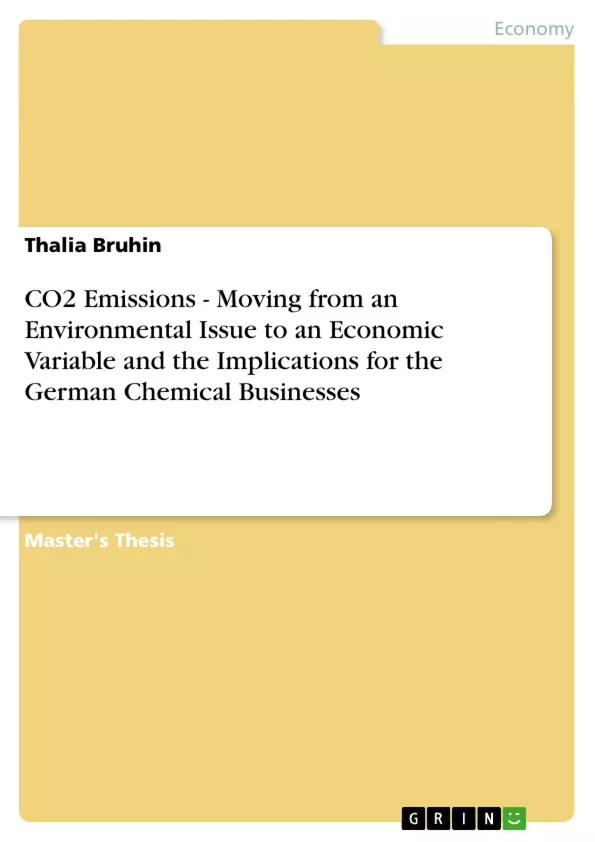Under the Kyoto Protocol, the European Union (EU) has introduced an Emissions Trading Scheme (ETS) in January 2005 in order to set economic limits to an environmental concern, global warming. This scheme covers industrial plants that can now trade allowances of carbon dioxide (CO2). This new carbon market is the largest of its sort, growing quickly and behaving very similarly to the stock markets. Because of being so new, there is still a considerable amount of uncertainty about its future development, but some first lessons are discussed in the report. Crucial is the allocation of allowances with all its exceptions that can lead to false incentives to actually increase emissions. Allowances now represent a cost that can either lead to competitive disadvantage or present an opportunity to increase margins if allocated for free. Investment decisions are being affected because environmental concerns are translated into a cost that can be evaluated against the costs of other alternatives. Consequences of the US being the worlds largest emitter not ratifying the Kyoto Protocol is addressed. Pitfalls of the system are identified and recommendations given.
This report intends to provide an overview on the current situation, focus on the German chemical industry, how it is affected in the short term and what can be expected from the future.
Inhaltsverzeichnis (Table of Contents)
- Abstract
- Preface
- 1 Introduction
- 2 What is the Kyoto Protocol?
- 3 EU Emissions Trading Scheme (EU ETS)
- 4 What does the EU ETS mean for the German chemical industry?
- 5 Allocation of Allowances
- 6 National Allocation Plan (NAP)
- 7 Investments and New Technologies
- 8 Implications for the German Chemical Industry
- 9 Conclusion
- Bibliography
Zielsetzung und Themenschwerpunkte (Objectives and Key Themes)
This report aims to provide a comprehensive overview of the European Union Emissions Trading Scheme (EU ETS) and its implications for the German chemical industry. The focus is on understanding how the EU ETS, implemented under the Kyoto Protocol, transforms CO2 emissions from an environmental issue into an economic variable. Key themes explored in this report include:- The implementation and operation of the EU ETS
- The impact of the EU ETS on the German chemical industry
- The allocation of carbon dioxide (CO2) allowances under the scheme
- The role of investments and new technologies in mitigating CO2 emissions
- The economic and environmental consequences of the EU ETS
Zusammenfassung der Kapitel (Chapter Summaries)
- Introduction: This chapter introduces the topic of CO2 emissions trading and its significance for the German chemical industry. It discusses the background of the Kyoto Protocol and the EU Emissions Trading Scheme, highlighting the rationale behind the scheme's implementation.
- What is the Kyoto Protocol?: This chapter delves into the Kyoto Protocol, explaining its key provisions and the role of the European Union in its implementation. It explores the objectives and mechanisms of the protocol, focusing on the emissions reduction targets set for various countries.
- EU Emissions Trading Scheme (EU ETS): This chapter provides a detailed explanation of the EU ETS, covering its structure, functioning, and key features. It discusses the trading of CO2 allowances, the establishment of a carbon market, and the implications for industries covered by the scheme.
- What does the EU ETS mean for the German chemical industry?: This chapter examines the specific impacts of the EU ETS on the German chemical industry. It analyzes the challenges and opportunities presented by the scheme for chemical businesses, including potential cost implications, competitiveness issues, and opportunities for innovation.
- Allocation of Allowances: This chapter focuses on the allocation of CO2 allowances under the EU ETS, exploring different methods and their implications. It examines the impact of allowance allocation on the competitiveness of various industries and the potential for unintended consequences.
- National Allocation Plan (NAP): This chapter discusses the development and implementation of the National Allocation Plan (NAP) in Germany. It explores the challenges and controversies surrounding the NAP, examining its effectiveness in achieving emissions reduction targets.
- Investments and New Technologies: This chapter examines the role of investments and new technologies in mitigating CO2 emissions within the context of the EU ETS. It explores how the scheme incentivizes or disincentivizes investments in low-carbon technologies and discusses the potential for technological breakthroughs to reduce emissions.
- Implications for the German Chemical Industry: This chapter explores the short-term and long-term implications of the EU ETS for the German chemical industry. It analyzes the potential for the scheme to drive innovation, reshape business models, and impact the sector's competitiveness.
Schlüsselwörter (Keywords)
This report focuses on the European Union Emissions Trading Scheme (EU ETS), the Kyoto Protocol, carbon dioxide (CO2) emissions, allowance allocation, and the German chemical industry. It explores the implications of CO2 emissions trading for businesses, examining key aspects such as market mechanisms, investment decisions, and technological advancements.- Citation du texte
- MBA Thalia Bruhin (Auteur), 2009, CO2 Emissions - Moving from an Environmental Issue to an Economic Variable and the Implications for the German Chemical Businesses, Munich, GRIN Verlag, https://www.grin.com/document/136698



